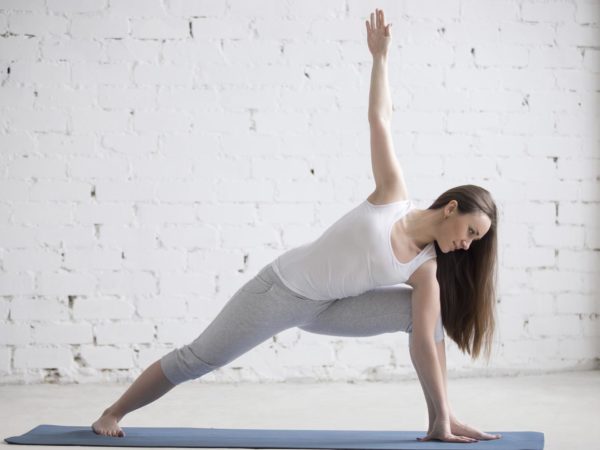Extended Side Angle Pose

“The Extended Side Angle Pose both strengthens and stretches, adding up to pure invigoration. In this pose – as in life – we need to both touch the ground and reach for the sky.” – Andrew Weil, M.D.
Description & History
The yoga pose Utthita Parsvakonasana is commonly known as the Extended Side Angle Pose. The pose name comes from the Sanskrit words utthita meaning extended, parsva meaning side or flank, kona meaning angle, and asana meaning posture. The Extended Side Angle Pose is closely related to the Triangle Pose and the Warrior I and II poses. The combination of a lunge and twisting of the spine can greatly increase both muscle strength of the legs and groin, while opening the chest and shoulders.
How To Perform Extended Side Angle Pose
- There are two starting positions for the Extended Side Angle Pose, so pick one that feels most comfortable to you:
- Start from Tadasana, or standing position, and move your legs out three to four feet apart and in a comfortable position. Turn your right foot 90 degrees away from the left and bend the right knee, keeping the left leg straight (you can also turn the left foot 45 degrees to the right). Bring the right knee to a right angle with the thigh parallel to the floor and directly aligned under your right foot.
- Start from Downward-Facing Dog and bring the right foot forward, placing it next to the right hand. Bend the right knee so the calf and thigh create a right angle, with the thigh parallel to the floor and the knee directly under your right foot.
- Keeping the heel of the left foot on the ground, exhale and lay the right side of your torso on, or as close as possible to, the top of the right thigh. Press the fingertips (or palm if possible) of the right hand on the floor just outside of your right foot.
- With pointed fingers, reach your left arm over your head. Visualize a straight line along your left side from the heel of your foot to the tips of your fingers. Turn your head to look at your extended arm
- Maintain the Extended Side Angle Pose for 30 seconds to one minute. When you are ready to release, inhale and press with your bent knee to bring your body into Tadasana, or standing position. Reverse the feet and repeat the same motions for the other side.
Potential Health Benefits Of The Extended Side Angle Pose
- Strengthens and stretches legs, knees, ankles and groin
- Opens chest, shoulders and lungs, aiding with breathing
- Improves flexibility of the spine and hips
- Stimulates abdominal organs and relieves constipation
- Helps with low back pain and sciatica
- Reduces menstrual discomfort
- Deepens breathing
A 2012 study published in the Journal of Sports Science and Medicine looked into the use of yoga to improve arterial compliance, or elasticity, and increase muscle strength. The eight-month study had participants perform a variety of leg-related yoga poses, one of which was the Extended Side Angle Pose. At the end of the study, researchers concluded that arterial compliance was not affected by the yoga poses. However, leg muscular strength improved in the yoga participants.
Modifications & Variations
The Extended Side Angle Pose can be difficult for beginners. Two problems a beginner often faces include limited flexibility that prevents comfortably placing the hand on the floor, and the inability to keep the heel of the back leg anchored to the floor. To help with flexibility, either rest the forearm on top of the bent thigh or place a yoga block on the outside of the front foot to support your hand. To help anchor the back heel to the floor, line up so your heel is resting against a wall just above the floor. When you bend your front leg, imagine you are pushing the wall away from you, using only your heel. This will help keep your back heel stable and in turn create a deeper stretch.
Advanced practitioners can deepen the Extended Side Angle Pose by placing the palm of the hand on the floor. Another variation is to place the hand on the inside of the thigh next to the arch of the foot instead of on the outside. This can cause the back to turn more and create a deeper stretch along the spine.
Precautions
People who commonly experience headaches should take caution when performing the Extended Side Angle Pose. Also, if you have high or low blood pressure, pay close attention to any warning signs including dizziness during the pose. Also, if you experience neck discomfort, you can keep the head in line with the chest to diminish the pain.
Related Poses
- Extended Triangle Pose (Utthita Trikonasana)
- High Lunge
- Low Lunge (Anjaneyasana)
- Warrior I Pose (Virabhadrasana I)
- Warrior II Pose (Virabhadrasana II)
Reviewed by: James Nicolai, M.D., on May 21, 2013
Sources
Kim, SoJung, Michael G. Bemben, and Debra A. Bemben. “Effects of an 8-month yoga intervention on arterial compliance and muscle strength in premenopausal women.” Journal of Sports Science and Medicine 11 (2012): 322-330.









